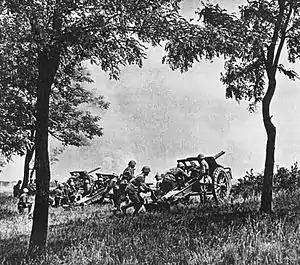10 cm houfnice vz. 30 (howitzer)
The 10 cm houfnice vz. 30 (howitzer model 30) was a Czechoslovak howitzer used in the Second World War. The 158 weapons captured after the German invasion of Czechoslovakia in March 1939 were taken into Wehrmacht service as the 10 cm leFH 30(t). It was used by a variety of German units during World War II, including II. and III./SS-Artillerie-Abteilung 3 between 1939 and 1940[2] and SS-Artillerie-Abteilung 51 during 1941.[3] 30 served with the Slovak Army.[4]
| 10 cm houfnice vz. 30 | |
|---|---|
 | |
| Type | Howitzer |
| Place of origin | Czechoslovakia |
| Service history | |
| In service | 1930-1945 |
| Used by | |
| Wars | World War II |
| Production history | |
| Designer | Skoda |
| Designed | 1928-1930 |
| Manufacturer | Skoda |
| Produced | 1932-39 |
| Specifications | |
| Mass | Combat: 1,766 kg (3,893 lb) Travel: 3,077 kg (6,784 lb) |
| Barrel length | 2.5 m (8 ft 2 in) L/25[1] |
| Shell weight | 16 kg (35 lb) |
| Caliber | 100 mm (3.94 in) |
| Carriage | box trail |
| Elevation | -8° to +80° |
| Traverse | 8°[1] |
| Rate of fire | 6-8 rpm |
| Muzzle velocity | 430 m/s (1,411 ft/s) |
| Maximum firing range | 10.6 km (6.6 mi)[1] |
Design and history
It was modified from an earlier Skoda design, the 10 cm houfnice vz. 28, that attempted to combine the field and mountain gun roles into one weapon. The Czechoslovak army decided to adopt it to replace their plethora of aged Austro-Hungarian field guns. They replaced the wheels with modern rubber-tired wheels, but curiously chose to retain the crewman's seat on the Gun shield. It used the same carriage as the 8 cm kanon vz. 30 that could break down into three pieces for transport . It fired a 16 kilograms (35 lb) shell.
Romania purchased a total of 500 pieces, 248 from Czechoslovakia in the mid-1930s and 252 from Germany in 1940–1941. Romania was not able to produce the whole piece by itself, but its Astra Works did manage to produce the gun barrel. Gun barrels of 100 mm were produced by Astra during the war for the replacement of damaged/worn-out barrels.[5]
Notes
- Chamberlain, Peter (1975). Light and medium field artillery. Gander, Terry. New York: Arco. p. 12. ISBN 0668038209. OCLC 2067331.
- Niehorster, Leo W. G. German World War II Organizational Series, Vol. 2/II: Mechanized GHQ units and Waffen-SS Formations (10 May 1940), 1990
- Niehorster, Leo W. G. German World War II Organizational Series, Vol. 3/II: Mechanized GHQ units and Waffen-SS Formations (22 June 1941), 1992
- Kliment and Nakládal, p. 122
- Mark Axworthy, London: Arms and Armour, 1995, Third Axis, Fourth Ally: Romanian Armed Forces in the European War, 1941–1945, p. 29
References
- Engelmann, Joachim and Scheibert, Horst. Deutsche Artillerie 1934-1945: Eine Dokumentation in Text, Skizzen und Bildern: Ausrüstung, Gliederung, Ausbildung, Führung, Einsatz. Limburg/Lahn, Germany: C. A. Starke, 1974
- Gander, Terry and Chamberlain, Peter. Weapons of the Third Reich: An Encyclopedic Survey of All Small Arms, Artillery and Special Weapons of the German Land Forces 1939-1945. New York: Doubleday, 1979 ISBN 0-385-15090-3
- Kliment, Charles K. and Nakládal, Bretislav. Germany's First Ally: Armed Forces of the Slovak State 1939-1945. Atglen, PA: Schiffer, 1997 ISBN 0-7643-0589-1